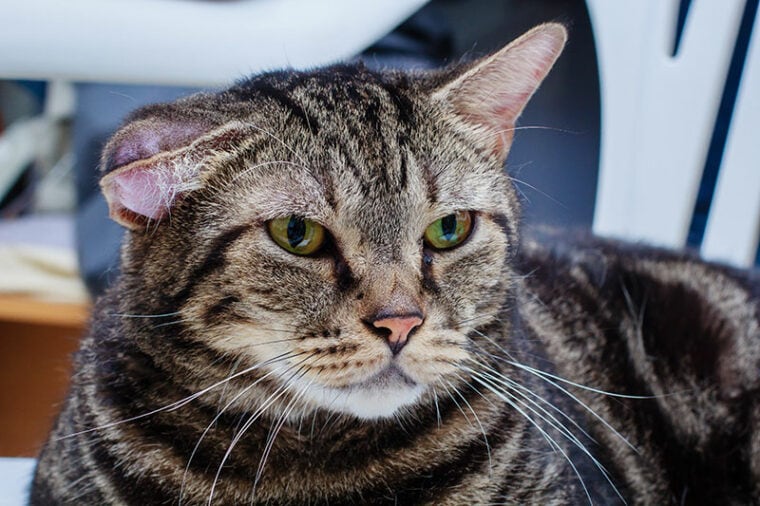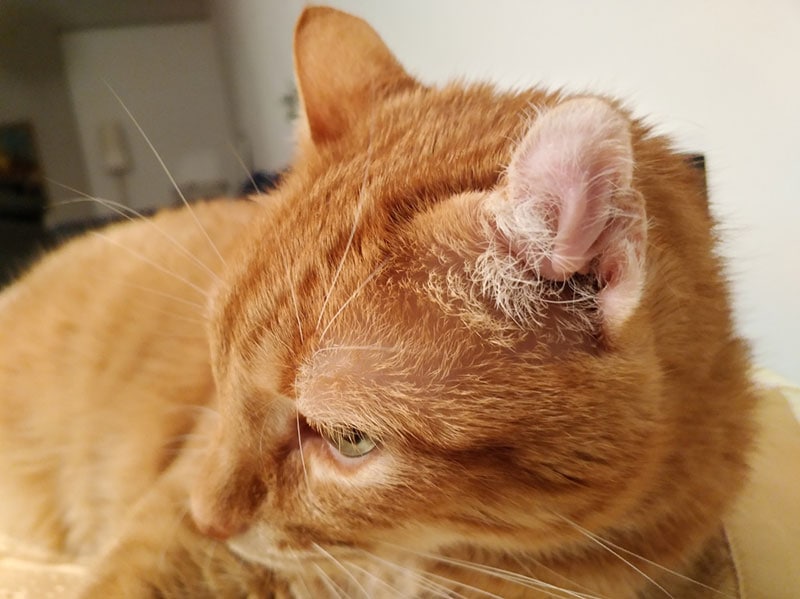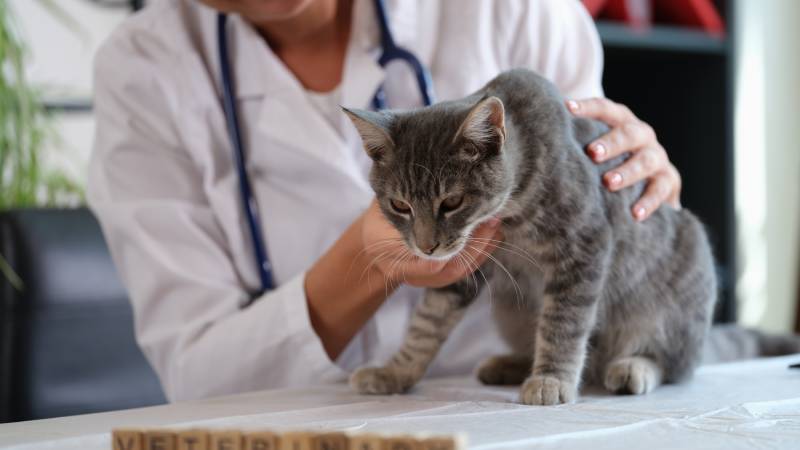
A hematoma is an abnormal collection or pooling of blood outside of a blood vessel. These pockets of blood primarily form when a blood vessel ruptures or breaks following injury or trauma. The damaged wall of the blood vessel leaks blood into the surrounding tissues, which can accumulate under the skin or in an organ. A hematoma is similar to a hemorrhage (bleeding), but the blood may be clotted in a hematoma, while a hemorrhage is ongoing, continuous bleeding.

What Is a Cat Ear Hematoma?
Cats can get hematomas in the pinna of their ears. The pinna is the outside, visible part of the ear, or the ear flap. Ear hematomas occur when blood is trapped between the cartilage and the skin of a cat’s pinna, also referred to as an auricle. Auricular hematoma is a common term when discussing this condition.

What Are the Signs of an Ear Hematoma in Cats?
There is little space between the ear cartilage and the skin that the blood seeps into. One or both ears may be affected, and only a small portion of the ear or the entire pinna can form a hematoma. Common signs of an ear hematoma in cats include:
What Are the Causes of an Ear Hematoma?
Ear hematomas in cats are most often caused by self-trauma of irritated or itchy ears, including scratching their ears and head shaking to try to rid themselves of the annoying sensation. Self-trauma can lead to ruptured blood vessels in the ear, which bleed into the limited space and form a hematoma. Ear hematomas may be uncomfortable or painful, which can exacerbate scratching and head shaking, worsening the problem.
Cats may scratch their ears or shake their heads due to an ear infection known as otitis externa, caused by bacteria, yeast, or parasites like ear mites. Other causes that may lead to an ear hematoma can include excessive hair in the ear canals, a foreign body/material, abnormal ear structure, or other skin problems, such as allergies. Trauma to the pinna, including bite wounds, can also lead to a hematoma. If your cat has a bleeding or clotting disorder, a hematoma may form in the absence of trauma.

How Do I Care for a Cat With an Ear Hematoma?
It’s important to figure out why a hematoma formed by determining the underlying cause and treating it. Diagnosis of a hematoma is based on your veterinarian’s physical exam findings and your cat’s previous medical history. Your vet may recommend examining your cat while they’re under sedation or anesthesia in order to get a good look at the ears and inside the ear canal. The exam may involve taking samples from your cat’s ears to look for bacteria, yeast, or parasites under a microscope and/or submitting samples for culture and sensitivity testing to find the right antibiotic to treat a bacterial infection. While examining your cat, your veterinarian will also look for any foreign bodies or structural abnormalities in their ears to help determine why a hematoma formed in the first place.
Your vet may recommend testing your cat for allergies—either dietary and/or environmental—or looking for skin parasites, such as fleas, that can cause itchiness and contribute to your cat scratching and traumatizing their ears.
The hematoma itself is treated by draining the blood out of it, either through a surgical procedure or by drawing out the excess fluid with a needle and syringe (known as fine needle aspiration, or FNA). Draining the hematoma is crucial to prevent permanent scarring and cauliflower ear. If non-surgical treatment is sought (FNA), the blood should be drained daily until the tissues, cartilage, and blood vessels heal. This may take several weeks and repeated visits to your veterinarian. Administering oral or injectable corticosteroids along with daily drainage of the hematoma may improve outcomes with non-surgical treatment.
During the healing process, your cat may need to wear an Elizabethan collar (e-collar) to prevent further trauma to the ears. To avoid reoccurrence, the underlying cause must be treated, whether it is an ear infection, allergies, or parasites. This may involve regular ear examinations and cleanings by your veterinarian.

Frequently Asked Questions (FAQs)
Can Dogs Get Hematomas?
Yes, dogs can get hematomas in their ears too, especially breeds with floppy, pendulous ears.
What Happens If I Don’t Treat My Cat’s Ear Hematoma?
Small hematomas may resolve on their own if the underlying condition is treated. However, untreated ear hematomas can lead to inflammation and excessive scarring of the tissues, resulting in a cauliflower-shaped ear, which can block the ear canal and be a cosmetic issue.

Is My Cat’s Ear Hematoma an Emergency?
While an ear hematoma is not an emergency, it should be addressed as soon as possible. The sooner it is treated and the underlying problem managed, the better the prognosis.

Conclusion
Ear hematomas are pockets of blood that form from broken or ruptured blood vessels, usually from self-inflicted trauma, such as scratching the ears or vigorous head shaking. Hematomas commonly form secondarily to an underlying condition like an ear infection, allergies, or parasites. Draining the hematoma, allowing the tissues to heal properly, and managing the underlying issue are necessary for a good outcome and to prevent reoccurrence.
Featured Image Credit: BabyMosquito, Shutterstock







